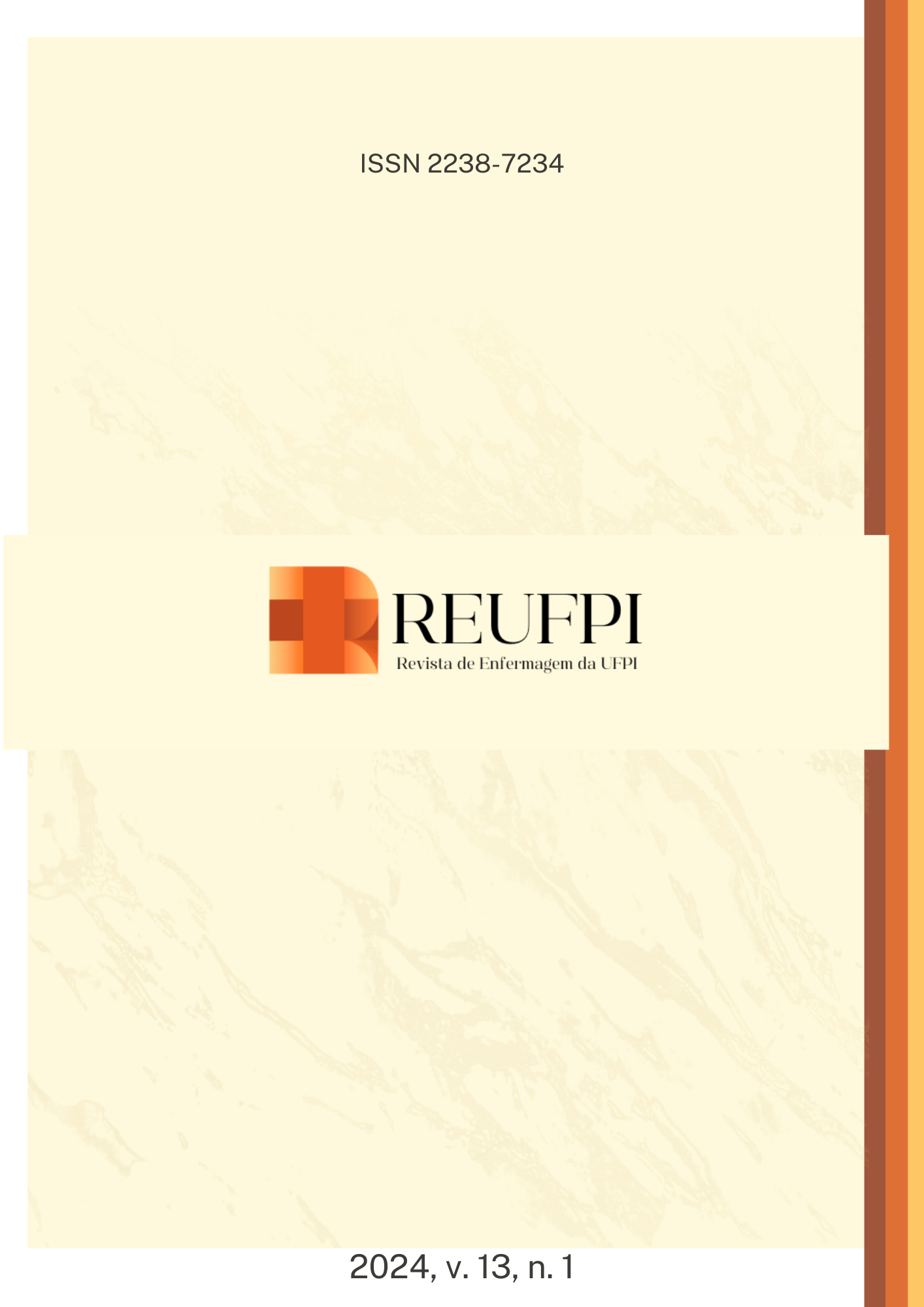Prevention and management of falls in hospitalized newborns: perspectives of mothers and nursing professionals
DOI:
https://doi.org/10.26694/reufpi.v13i1.5137Keywords:
Infant, Newborn, Hospitals, Maternity, Rooming-in Care, Accidental Falls, Patient SafetyAbstract
Objective: to understand the perceptions of mothers and nursing professionals about the prevention and management of falls in hospitalized newborns. Methods: exploratory and qualitative study, resulting from experimental development research based on Design Thinking. This article addresses the stages of Empathy and Definition carried out with 20 nursing professionals and 34 mothers hospitalized in the Rooming-In Care of the Public Maternity Hospital of Fortaleza in 2023. For data collection, interviews, observation, photographic records and document analysis were used. The findings were submitted to Content Analysis using the MAXQDA software. Approval was obtained from the Ethics Committee (nº 5,974,647/2023). Results: a total of 485 context units were evidenced, distributed in six thematic categories. The participants revealed incidents of witnessed/known falls, contributing factors (maternal exhaustion, sleeping with the NB in bed or breastfeeding, carrying NB in the lap, bed rails lowered); consequences (trauma, fractures, fear, sense of guilt); and behaviors for prevention and intervention (staying alert when breastfeeding, raising bed rails, keeping baby in the crib, safe transportation, providing educational material for mothers). Conclusion: mothers and professionals know the contributing factors and consequences of neonatal falls, and there is an urgent need for their integration as protagonists in actions [...].
References
Balsarkar G. World Patient Safety Day 2021: Safe Maternal and New Born Care. J Obstet Gynaecol India. 2021;71(5):465-7. doi: https://doi.org/10.1007/s13224-021-01547-1
Ministério da Saúde (BR). Portaria nº 529, de 1º de abril de 2013. Institui o Programa Nacional de Segurança do Paciente (PNSP). Brasília: Diário Oficial da República Federativa do Brasil; 2013. Available from: https://bvsms.saude.gov.br/bvs/saudelegis/gm/2013/prt0529_01_04_2013.html
Driscoll CAH, Pereira N, Lichenstein R. In-hospital Neonatal Falls: An Unintended Consequence of Efforts to Improve Breastfeeding. Pediatrics. 2019;143(1):e20182488. doi: https://doi.org/10.1542/peds.2018-2488
Miner J. Implementation of a Comprehensive Safety Bundle to Support Newborn Fall/Drop Event Prevention and response. Nursing for Women’s Health. 2019;23(4):327-39. doi: https://doi.org/10.1016/j.nwh.2019.06.002
Ministério da Saúde (BR). Sistema de Informação sobre Mortalidade. Brasília: Ministério da Saúde; 2017.
World Health Organization. Handbook for Guideline Development. 2nd ed. WHO; 2018. Available from: https://www.who.int/publications/i/item/9789241548960
Mitchell EA, et al. Falls of newborn infants in a New Zealand hospital: A case series. J Paediatrics Child Health. 2023;59(2):253-7. doi: https://doi.org/10.1111/jpc.16275
Sousa Neto AL, Brito Röder DVDD. Gestão de segurança quanto à quedas de recém-nascidos hospitalizados: uma revisão integrativa. Brazilian Journal of Development. 2021;7(6):57943-55. doi: https://doi.org/10.34117/bjdv7n6-275
Kukielka E, Wallace SC. Newborn falls in Pennsylvania: an analysis of recent events and a review of prevention strategies. Patient Safety. 2019;1(2):51-9. doi: https://doi.org/10.33940/falls/2019.12.5
Scherba JC, et al. Identification of Temporal Variables Surrounding Infant Falls in the Postpartum Unit. Clin Pediatr. 2020;59(14):1290-1292. doi: https://doi.org/10.1177/0009922820942877
Brown T. Design Thinking: Uma metodologia poderosa para decretar o fim das velhas ideias. Rio de Janeiro: Elsevier Ltd; 2010.
Bardin L. Análise de Conteúdo. São Paulo: Edições 70; 2011.
Ministério da Saúde (BR). Conselho Nacional de Saúde. Resolução Nº 466, de 12 de dezembro de 2012. Diretrizes e normas regulamentadoras de pesquisa envolvendo seres humanos. Brasília, DF: Ministério da Saúde; 2012. Available from: https://conselho.saude.gov.br/ultimas_noticias/2013/06_jun_14_publicada_resolucao.html
Silva WC, et al. Análise da ocorrência de incidentes notificados no ambiente hospitalar de uma maternidade pública. Rev Eletr Acervo Saúde. 2019;34:e1445. doi: https://doi.org/10.25248/reas.e1445.2019
Bittle MD, et al. Maternal Sleepiness and Risk of Infant Drops in the Postpartum Period. Jt Comm J Qual Patient Saf. 2019;45(5):337-47. doi: https://doi.org/10.1016/j.jcjq.2018.12.001
Loyal J, et al. Newborn falls in a large tertiary academic center over 13 years. Hosp Pediatr. 2018;8(9):509-14. doi: https://doi.org/10.1542/hpeds.2018-0021
Lakra MS, Lakhkar B. Neonatal fall risk-assessment in hospitals: Are we compromising neonatal safety in developing countries? Sri Lanka J Child Health. 2022;51(2):282-2893. doi: https://doi.org/10.4038/sljch.v51i2.10134
Duthie EA. In-hospital newborn falls associated with a sleeping parent: the case for a new paradigm. Hosp Pediatr. 2020;10(12):1031-7. doi: https://doi.org/10.1542/hpeds.2020-0112
Lipke B, et al. Newborn Safety Bundle to Prevent Falls and Promote Safe Sleep. Am J Matern Child Nurs. 2018;43(1):32-7. doi: https://doi.org/10.1097/NMC.0000000000000402
Carr H, et al. A System-Wide Approach to Prevention of In-Hospital Newborn Falls. Am J Matern Child Nurs. 2019;44(2):100-7. doi: https://doi.org/10.1097/NMC.0000000000000516
Rodrigues GT, et al. Incidentes na assistência das parturientes e recém-nascidos: perspectivas das enfermeiras e médicos. Esc Anna Nery. 2021;25(2):e20200075. doi: https://doi.org/10.1590/2177-9465-EAN-2020-0075
Downloads
Published
How to Cite
Issue
Section
License
Copyright (c) 2024 Rev Enferm UFPI

This work is licensed under a Creative Commons Attribution 4.0 International License.
Autores mantém os direitos autorais e concedem à REUFPI o direito de primeira publicação, com o trabalho licenciado sob a Licença Creative Commons Attibution BY 4.0 que permite o compartilhamento do trabalho com reconhecimento da autoria e publicação inicial nesta revista.

























